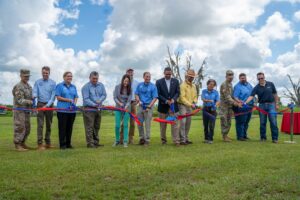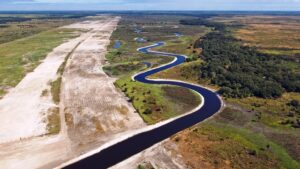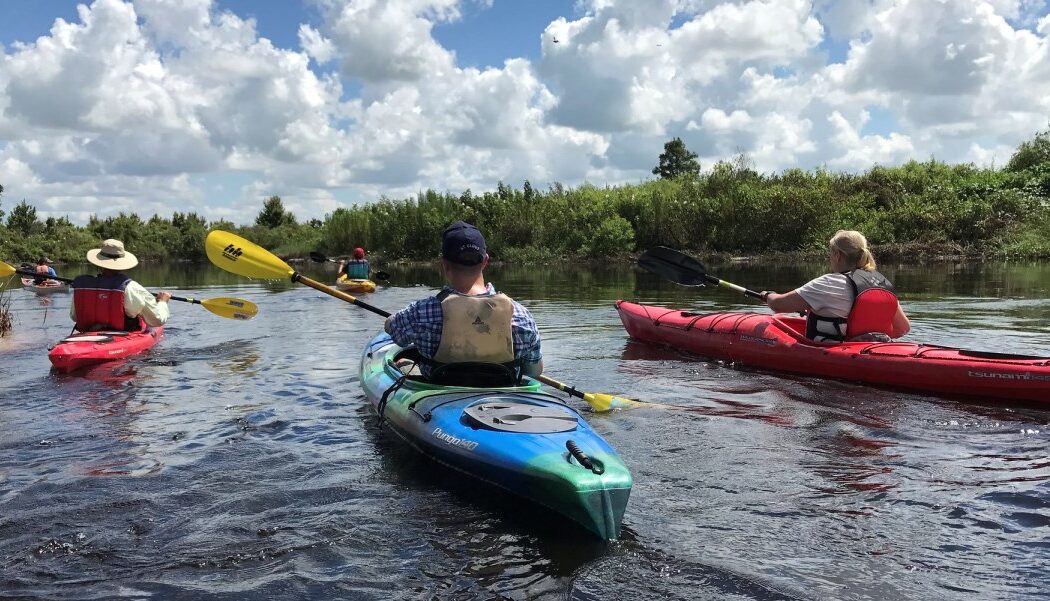The Kissimmee River once meandered for 103 miles through central Florida. Its floodplain, reaching up to 3 miles wide, was inundated for long periods by heavy seasonal rains.
Native wetland plants, wading birds and fish thrived there. Then, the U.S. Army Corps of Engineers destroyed it.
 On July 29, 2021 the U.S. Army Corps of Engineers Jacksonville District (USACE) hosted a ribbon-cutting event to celebrate the completion of the construction for the Kissimmee River Restoration Project. The Kissimmee River Restoration Project restores more than 40 square miles of the river floodplain ecosystem, 20,000 acres of wetlands, and 44 miles of the historic river channel.
On July 29, 2021 the U.S. Army Corps of Engineers Jacksonville District (USACE) hosted a ribbon-cutting event to celebrate the completion of the construction for the Kissimmee River Restoration Project. The Kissimmee River Restoration Project restores more than 40 square miles of the river floodplain ecosystem, 20,000 acres of wetlands, and 44 miles of the historic river channel.
Now, after 22 years of work, they have repaired much of the structural damage they inflicted. It’s a good example of the dynamic stated in the 2020 book, RECONOMICS: The Path To Resilient Prosperity: “80% of the revitalizing, resilience-enhancing work done by urban planners and civil engineers in the 21st century will undo 80% of the work done by their predecessors in the 20th century.”
Why did they destroy it in the first place? After prolonged natural flooding in 1947, major corporate landowners, farmers and sprawling cities called on the federal government to make nature stop behaving naturally.
So, in 1948, the U.S. Congress authorized the U.S. Army Corps of Engineers to remove the river’s curves and turn it into a near-lifeless canal (civil engineers tend to worship at the alter of straight lines and 90-degree angles) via the Central and South Florida Project. The beautiful, productive river thus became the hideous C-38 Canal.
The result was the destruction of most of the floodplain-dependent ecosystem that had nurtured threatened and endangered species for millennia. Hundreds of other native fish and wetland-dependent animals went from plentiful to threatened or endangered status.
More than 90 percent of the waterfowl that once graced the wetlands disappeared and the number of bald eagle nesting territories decreased by 70 percent. After the waterway was transformed into a straight, deep canal, it became oxygen-depleted, and the fish community it supported changed dramatically.
But engineers do what they’re paid to do, and they’ve spent the past 22 years undoing much of that damage. More intelligent leaders finally had their way, stimulated by numerous lawsuits from environmental organizations.
 “Today we mark the completion and monumental achievement of the Kissimmee River Restoration Project. For more than two decades, the Army Corps of Engineers and the South Florida Water Management District have worked tirelessly to restore this critical ecosystem. The credit for this unprecedented success rightly belongs to the countless hard-working men and women in both the Army Corps and the South Florida Water Management District,” said Jaime Pinkham, Acting Assistant Secretary of the Army for Civil Works.
“Today we mark the completion and monumental achievement of the Kissimmee River Restoration Project. For more than two decades, the Army Corps of Engineers and the South Florida Water Management District have worked tirelessly to restore this critical ecosystem. The credit for this unprecedented success rightly belongs to the countless hard-working men and women in both the Army Corps and the South Florida Water Management District,” said Jaime Pinkham, Acting Assistant Secretary of the Army for Civil Works.
“While we celebrate, we are also reminded of the tremendous amount of work left to be done. President Biden has prioritized environmental restoration in the Everglades, including the largest budget request for the Comprehensive Everglades Restoration Plan since its inception. This administration, and my office pledge to continue our work with our Congressional allies to provide the necessary resources to fulfill our commitment here,” he added.
The Kissimmee River Restoration Project began in 1999 with backfilling 8 miles of the C-38 canal. Three construction phases are now complete, and continuous water flow has been re-established to 24 miles of the meandering Kissimmee River. Seasonal rains and flows now inundate the floodplain in the restored area.
The Kissimmee River Restoration Project has returned flow to 44 miles of the river’s historic channel and restore about 40 square miles of river/floodplain ecosystem.
“As the headwaters of America’s Everglades, the restored Kissimmee River and its floodplain is a legacy for future generations,” said Shannon Estenoz, Assistant Secretary for Fish and Wildlife and Parks at the U.S. Department of the Interior. “The Kissimmee proves that when we work together and follow the science, we can bring ecosystems back to health to deliver invaluable services, including wildlife habitat, recreation, climate resilience and water management.”
“The Kissimmee River Restoration Project was the first successful large-scale active riverine ecosystem restoration project in the country, and even in the world,” said Col. Andrew Kelly, U.S. Army Corps of Engineers Jacksonville District Commander.
This major restoration effort is a 50-50 partnership between the U.S. Army Corps of Engineers and the South Florida Water Management District (SFWMD).
Over the past 22 years, the USACE and SFWMD has worked together to:
- Complete backfilling of 22-miles of the C-38 canal between Lakes Kissimmee and Okeechobee;
- Reconstruct remnant river channels across the backfilled canal to reconnect and restore flow in remnant river channels;
- Remove two water control structures;
- Add two gates to the S-65 water control structure;
- Acquire more than 100,000 acres of land to restore the river and floodplain.
 “All eyes were on us. The world watched as we set the standard and created the model for science-based ecosystem restoration projects worldwide. The Kissimmee River Restoration is proof positive that if we build it right, they will come, and serves as the foundation for the Comprehensive Everglades Restoration Plan. Today, we celebrate the completion of the construction phase with many of the people who have worked hard to maintain the momentum on this project for more than 30 years. We owe all of our partners a huge debt of gratitude for their continued support,” he continued.
“All eyes were on us. The world watched as we set the standard and created the model for science-based ecosystem restoration projects worldwide. The Kissimmee River Restoration is proof positive that if we build it right, they will come, and serves as the foundation for the Comprehensive Everglades Restoration Plan. Today, we celebrate the completion of the construction phase with many of the people who have worked hard to maintain the momentum on this project for more than 30 years. We owe all of our partners a huge debt of gratitude for their continued support,” he continued.
Since the project began in 1999, the river and its floodplain improved in many ways, including the conversion of nearly 20,000 acres of drained floodplain to ecologically beneficial wetlands.
“The Kissimmee River is a significant part of America’s Everglades and this project is vital to restoring the greater Everglades ecosystem. This milestone is a testament to the ingenuity and dedication of the people who have worked to complete this project over the past 20 years,” said Florida Department of Environmental Protection Interim Secretary Shawn Hamilton.
In addition, the project’s efforts resulted in the recovery of the invertebrate community, a crucial food resource for fish and birds. Today marks the completion of the project’s construction activities.
“It’s so gratifying to see the years of hard work and determination culminating in a manner that is easy to observe on a grand scale by Mother Nature. This river and the efforts required for it to be restored were nothing short of amazing! I am so happy for our state – and our region specifically – to see this project completed,” said Karson Turner, Chairman of the County Coalition.
“Thanks to all who worked so tirelessly to make it a reality. This restoration project touches and enhances ecosystems that all Floridians will benefit from for generations. We got it right this time!” he exulted.
Additional monitoring will be conducted to measure the project’s success, and additional projects and restoration efforts in the region will support continued restoration of Florida’s iconic Kissimmee River.
The 2002 book, The Restoration Economy, predicted that the primary work of the U.S. Army Corps of Engineers would soon be restoration, much of which would undo what they had accomplished over the previous two centuries. While they are, in fact, doing a tremendous amount of restoration, many question whether the institution’s culture and mindset has yet evolved in that direction.
All photos courtesy of U.S. Army Corps of Engineers.

